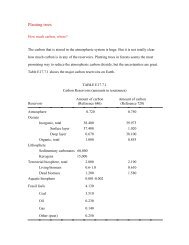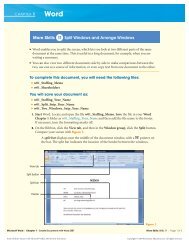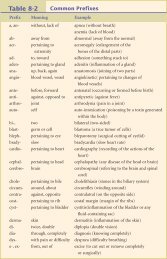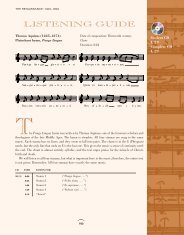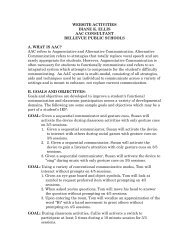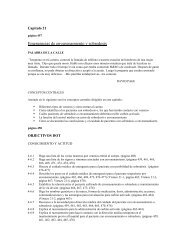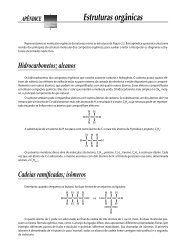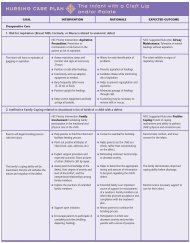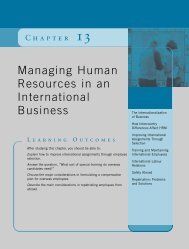chapter
chapter
chapter
You also want an ePaper? Increase the reach of your titles
YUMPU automatically turns print PDFs into web optimized ePapers that Google loves.
208 Unit Three Forces Within<br />
meters apart and are built upon submerged ridges a<br />
few hundred kilometers wide. This newly formed land<br />
consisting of an arc-shaped chain of small volcanic islands<br />
is called a volcanic island arc. The Aleutian, Mariana,<br />
and Tonga islands are examples of volcanic island<br />
arcs (see Box 7.2). Island arcs such as these are gen-<br />
UNDERSTANDING EARTH:<br />
Susan DeBari—A Career in Geology<br />
Idiscovered geology<br />
the summer that<br />
I worked doing trail maintenance in the<br />
North Cascades mountains of Washington<br />
State. I had just finished my<br />
freshman year in college and had never<br />
before studied Earth Science. But a<br />
coworker (now my best friend) began<br />
to describe the geological features of the<br />
mountains that we were hiking in—the<br />
classic cone shape of Mount Baker volcano,<br />
the U-shaped glacial valleys, the<br />
advance of active glaciers, and other<br />
wonders. I was hooked and went back<br />
to college that fall with a geology passion<br />
that hasn’t abated. As an undergraduate,<br />
I worked as a field assistant<br />
to a graduate student and did a senior<br />
thesis project on rocks from the Aleutian<br />
island arc. From that initial spark,<br />
island arcs have remained my top<br />
research interest, on through Ph.D. research<br />
at Stanford University, postdoctoral<br />
work at the University of Hawaii,<br />
and as a faculty member at San Jose<br />
State University and Western Washington<br />
University.<br />
Especially the deep crust of arcs, the<br />
material that lies close to the Mohorovic˘ic˘<br />
discontinuity (fondly known<br />
as the Moho). What kinds of processes<br />
are occurring down there at the base of<br />
the crust in island arcs? What is the<br />
source of magmas that make their way<br />
to the surface (the mantle? the deep<br />
crust itself?). How do these magmas interact<br />
with the crust as they make their<br />
way upwards? What do these early<br />
magmas look like chemically? Are they<br />
very different from what is erupted at<br />
the surface?<br />
Obviously, geologists cannot go<br />
down to the base of the crust (typically<br />
20 to 40 kilometers beneath Earth’s surface).<br />
So what they do is play a bit of a<br />
detective game. They must use rocks<br />
that are now exposed at the surface that<br />
were originally formed in the deep<br />
crust of an island arc. The rocks must<br />
have been brought to the surface rapid-<br />
BOX 7.2<br />
ly along fault zones to preserve their<br />
original features. Thus, I can walk on<br />
rocks of the deep crust without really<br />
leaving the Earth’s surface! There are a<br />
few places around the world where<br />
these rare rocks are exposed. Some of<br />
the places that I have worked include<br />
the Chugach Mountains of Alaska, the<br />
Sierras Pampeanas of Argentina, the<br />
Karakorum range in Pakistan, Vancouver<br />
Island’s west coast, and the North<br />
Cascades of Washington. Fieldwork has<br />
involved hiking most commonly, but<br />
also extensive use of mules and trucks.<br />
I also went looking for exposed<br />
pieces of the deep crust of island arcs in<br />
a less obvious place, in one of the deepest<br />
oceanic trenches of the world, the<br />
Izu Bonin trench (Figure 7.B). Here I<br />
dove into the ocean in a submersible<br />
called the Shinkai 6500 (pictured to my<br />
right in the background). The Shinkai<br />
6500 is a Japanese submersible that has<br />
the capability to dive to 6500 meters<br />
below the surface of the ocean (approx-<br />
erally located 200 to 300 kilometers from the trench<br />
axis. Located adjacent to the island arcs just mentioned<br />
are the Aleutian trench, the Mariana trench, and the<br />
Tonga trench (Figure 7.13).<br />
Only two volcanic island arcs are located in the Atlantic,<br />
the Lesser Antilles arc adjacent to the Caribbean<br />
imately 4 miles). My plan was to take<br />
rock samples from the wall of the trench<br />
at its deepest levels using the submersible’s<br />
mechanical arm. Because<br />
preliminary data suggested that vast<br />
amounts of rock were exposed for several<br />
kilometers in a vertical sense, this<br />
could be a great way to sample the deep<br />
arc basement. I dove in the submersible<br />
three times, reaching a maximum depth<br />
of 6497 meters. Each dive lasted 9<br />
hours, spent in a space no bigger than<br />
the front seat of a Honda, shared with<br />
two of the Japanese pilots that controlled<br />
the submersible’s movements. It<br />
was an exhilarating experience!<br />
I am now on the faculty at Western<br />
Washington University where I continue<br />
to do research on the deep roots of<br />
volcanic arcs, and get students involved<br />
as well. I am also involved in Science<br />
Education training for K–12 teachers,<br />
hoping to get young people motivated<br />
to ask questions about the fascinating<br />
world that surrounds them!<br />
Figure 7.B Susan DeBari photographed with the Japanese submersible, Shinkai 6500,<br />
which she used to collect rock samples from the Izu Bonin trench. (Photo courtesy of<br />
Susan DeBari)




